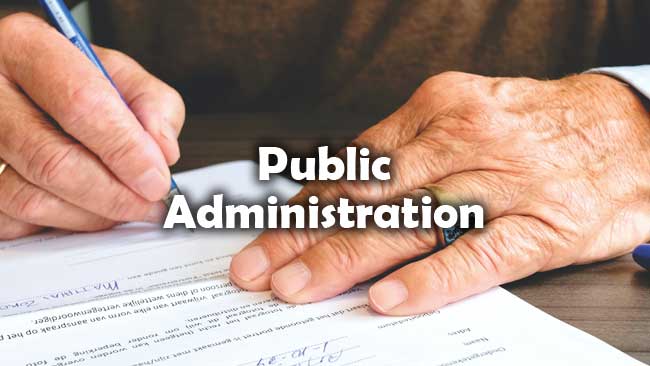Public Administration MCQ
Public Administration MCQ question paper pdf for examination is given below. This helps in analyzing Public Administration question and answers.

Public Administration exam MCQ question papers direct download links are given in this section. Hence, download the Public Administration MCQ Paper pdf below. Public Administration MCQ Papers Pdf help the applicants in their preparation.
MCQ Question Papers on Public Administration
1. The Child Development Centres established under National Rural Health Mission mainly is concerned with :
(A) Education of Children
(B) Malnutrition
(C) Vocational Training
(D) Socialization
2. Ahimsa Messenger Programme aims at :
(A) Care of the Aged
(B) Development of Children
(C) Non-violence attitude towards animals
(D) Empowering women against atrocities
3. Mass Mobilisation campaigns aim at :
(A) Social Justice
(B) Social Change
(C) Social Welfare
(D) Promotion of NGOs
4. Economic Survey in India is published by :
(A) Reserve Bank of India
(B) Planning Commission of India
(C) Ministry of Finance, Government of India
(D) Ministry of Industries, Government of India
5. What percent of reservation is given to other backward classes in Panchayati Raj under by the Constitution ?
(A) 15
(B) 27
(C) Left to states
(D) In proportion to their population
6. “It transforms representative democracy into parliamentary democracy.” This refers to :
(A) Directive principles
(B) Adult Suffrage
(C) 73rd Constitutional Amendment
(D) Rights to Information
7. The smallest unit of the Local Government in France is :
(A) Canton
(B) Commune
(C) Arrondisement
(D) Parish
8. No civil servant is required to resign if elected as chairperson of Local Body in :
(A) UK
(B) USA
(C) India
(D) France
9. According to whom “Administration is a type of co-operative effort that has a high degree of rationality” ?
(A) Luther Gullick
(B) Brooks Adams
(C) D. Waldo
(D) F.M. Marx
10. For mal-administration new public management holds responsible :
(A) Policy makers
(B) Bureaucracy
(C) Market competitiveness
(D) Consumerism
11. Herbert Simon’s contribution is significant in the field of :
(A) Communication
(B) Decision making
(C) Leadership
(D) Authority
12. The fundamental characteristics of Weberian model of bureaucracy is :
(A) System of rules
(B) Hierarchy
(C) Human relations
(D) Competency
13. The first major exponent of the traditional theory of motivation is :
(A) F.W. Taylor
(B) Henri Fayol
(C) McGregor
(D) Maslow Abraham
14. Herzberg has written a book entitled :
(A) Work and Nature of Man
(B) Changing Organizations
(C) Human Relations in Organization
(D) Politics of Bureaucracy
15. Flat structures facilitate :
(A) Close supervision
(B) Lateral communication
(C) Initiative
(D) Co-ordination
16. According to which theory “leadership is multi-dimensional” ?
(A) Behavioural
(B) Situational
(C) Trait
(D) Path-Goal
17. The first comparativist in Public Administration is said to be :
(A) Kautilya
(B) Machiavelli
(C) Woodrow Wilson
(D) Fred Riggs
18. For development Montgomery concentrated specially on :
(A) Internal Security
(B) Communication
(C) Health & Education
(D) Infrastructure
19. The country that does not have permanent and professional bureaucracy at the policy-making level is :
(A) U.S.A.
(B) India
(C) U.K.
(D) France
20. One of the classical approach to the study of Comparative Public Administration is :
(A) Cyclic study approach
(B) Behavioural approach
(C) Legal approach
(D) Interdisciplinary approach
| GK | Old Question |
| MCQ | Previous Question |
| Quiz | UGC NET |
| Sample Question | IGNOU MPA |
| Model Papers | UPSC |
21. In U.S., U.K. and India the hierarchical ladder in the departments is :
(A) Rigid
(B) Flexible
(C) Less important
(D) Ignored
22. The stronger position of the U.S. President is somewhat neutralised by his lack of control over :
(A) Secretaries of State
(B) Congress
(C) Government departments
(D) Judiciary
23. Increasing role of bureaucrats in policy making in India is due to :
(A) Political instability
(B) Technical nature of the policies
(C) Role of interest groups
(D) Growing interaction between politicians and administrators
24. The main aim of ‘Development Administration’ is to :
(A) Increase income
(B) Adopt e-Governance
(C) Provide social security
(D) Enrich the quality of life
25. Fred Riggs describes the relationship between ‘Development Aministration and Administrative Development’ as :
(A) two sides of one coin
(B) Chicken and egg
(C) Contradictory
(D) Supplementary
26. The most debated problem of public sector is :
(A) Excessive bureaucratisation
(B) Lack of autonomy
(C) Political interference
(D) Lack of funds
27. Who are authors of ‘Development Debate’ ?
(A) Pai Panandikar and M.P. Sharma
(B) Ferrel Heddy and Montgomery
(C) Fred Riggs and Daya Krishna
(D) Weidner and Polombara
28. State undertakings are development administration as these are :
(A) Planned structure
(B) Capital intensive
(C) Community oriented
(D) State-administered
29. Good informal organisation rest on :
(A) effective co-ordination
(B) supportive processes
(C) informal interaction
(D) flexibility
30. Assertion (A) and Reason (R) :
Assertion (A) — Public administration differs from private administration in measurement of efficiency.
Reason (R) — Private administration is profit oriented.
Answer the question by using the code given below :
Code :
(A) Both (A) and (R) are true and (R) is the correct explanation of (A)
(B) Both (A) and (R) are true but (R) is not the correct explanation of (A)
(C) (A) is true but (R) is false
(D) (A) is false but (R) is true
31. Which British Act made government a ‘Responsible Government’ in India ?
(A) 1909
(B) 1919
(C) 1935
(D) 1947
32. ‘Departmentalization of Accounts’ in India started from :
(A) 1985
(B) 1976
(C) 1973
(D) 1968
33. Who, for the first time called the Indian Civil Service as “The Steel Frame of India” ?
(A) Lord Kimberley
(B) Loyd George
(C) Lee Commission
(D) Sardar Patel
34. Which Article of Indian Constitution is related with Central Finance Commission ?
(A) 280
(B) 281
(C) 290
(D) 291
35. Generalists are more suitable to higher posts because of their :
(A) Broad outlook
(B) Professionalism
(C) Special knowledge
(D) Courteous behaviour
36. Which the following does not operate under the direction of Prime Minister ?
(A) Cabinet Secretariat
(B) Parliamentary Secretariat
(C) Prime Minister’s Office
(D) National Development Council
37. Neutrality lies in :
(A) Indifference to policy matters
(B) Non-partisanship
(C) Response to will of every government
(D) Keeping distance from public
38. States in India can borrow provided :
(1) Union Government agrees
(2) No outstanding loan with the Union
(3) State Legislatures pass such resolution
(4) State Finance Department so approves
Select the correct answer from the codes given below :
Code :
(A) (1) and (2)
(B) (2) and (3)
(C) (1) and (3)
(D) (3) and (4)
39. Which amongst the following is an area of Planning Commission ?
(A) Review of governmental finances
(B) Maintain macro-economic stability
(C) Public and foreign loans
(D) Suggest restructuring of finance
40. Satishchandra Committee was related with civil services in the context of :
(A) Recruitment
(B) Promotion
(C) Training
(D) retirement
41. Which of the following plans has “Inclusive growth” as a main theme ?
(A) First Five Year Plan
(B) Fifth Five Year Plan
(C) Tenth Five Year Plan
(D) Eleventh Five Year Plan
42. Who was the Chairman of II Administrative Reforms Commission?
(A) Veerappa Moily
(B) Pranab Mukherji
(C) M.S. Ahluwalia
(D) P. Vitthal
43. A good hypothesis is difficult in the absence of :
(A) Theoretical outline
(B) Ability to use
(C) Technical knowledge
(D) Culture boundedness
44. Statistical analysis is used in :
(A) Quantitative research
(B) Qualitative research
(C) Comparative research
(D) Social research
45. In a Questionnaire the questions should not be :
(A) Limited in number
(B) Unambiguous
(C) Specific
(D) Personal
46. ‘Statistical Package for Social Sciences’ (SPSS) is used for :
(A) Data processing
(B) Data collection
(C) Data analysis
(D) Report writing
47. What is a catalyst of social change ?
(A) Basic education
(B) Health
(C) Poverty reduction
(D) Environmental protection
48. Which of the following legislations is not related to the protection of vulnerable sections of society ?
(A) The Equal Remuneration Act
(B) The Dowry Prohibition Act
(C) National Rural Employment Guarantee Act
(D) The Child Marriage Act
49. Privatisation is :
(1) A universal concept
(2) A gradual process
(3) A total denationalisation
(4) An increase in public ownership
Select the correct answer from the codes given below :
Codes :
(A) (1) and (3)
(B) (1), (2) and (3)
(C) (3) and (4)
(D) (2), (3) and (4)
50. The principal funding to public enterprises is by :
(A) The Government
(B) Banks
(C) Finance Commission
(D) Financial Institutions

